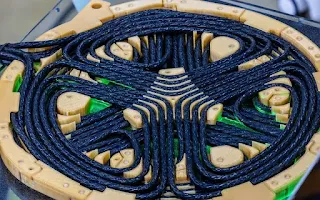 |
| Showcase of a wireless charging system that successfully transferred 270 kilowatts of power to a Porsche Taycan EV. Image credit: IEEE Spectrum |
Oak Ridge National Laboratory (ORNL) has achieved a significant milestone in wireless EV charging by successfully charging a Porsche Taycan EV at a record 270 kilowatts. This breakthrough comes just three months after ORNL set a previous record with a 100-kW wireless charge for a Hyundai Kona.
Innovative Technology and Design
- High-Efficiency System:
- The ORNL system uses a magnetic resonance transmitter pad paired with a receiver mounted to the car's underside.
- It employs polyphase windings—lightweight electromagnetic coils arranged to generate a rotating magnetic field, eliminating current ripples and field cancellation.
- Compact and Powerful:
- The 270-kW receiver fits into a space designed for a potential 11-kW charger in the Taycan, with the coils measuring less than 50 cm in diameter.
- The system delivers over 95% efficiency and significantly higher power density compared to single-phase wireless chargers.
 |
| The lightweight polyphase coupling coils of the EV charging system generate a rotating magnetic field, enabling continuous power transfer. Image credit: IEEE Spectrum |
Benefits Over Wired Systems
- Ease of Use:
- No need for bulky charging cables, making it especially beneficial for elderly and handicapped users.
- Reduces risk of cable theft and vandalism.
- Maintenance and Reliability:
- Requires less maintenance compared to liquid-cooled DC cables, which often need component replacements.
- Avoids power reduction issues caused by overheating in conventional DC cables.
Flexibility and Compatibility
- Versatile Charging:
- The system can charge vehicles with varying ground clearances, from low-slung cars to delivery trucks and semi-trailers.
- Capable of functioning efficiently even if the car is misaligned by over 12 cm.
- Ideal for Automated Vehicles:
- Perfect for robotaxis and delivery services where drivers cannot manually plug in vehicles.
- Allows for automated wireless refueling by simply parking over the charging pad.
Safety and Future Applications
- Safety Compliance:
- Meets all electromagnetic field emission limits, emitting a safe 19 µT at 270 kW without shielding.
- Future Prospects:
- Early deployments may focus on home charging pads delivering 11 to 22 kilowatts.
- Commercial applications are still years away but hold potential for use in smartphones, industrial equipment, and mobile robots.
Long-Term Research and Collaborations
ORNL’s decade-long research in wireless charging has been supported by collaborations with major automakers like Volkswagen, Hyundai, and Stellantis, funded by the U.S. Department of Energy. The recent Porsche project initiated in 2021 represents a significant step forward, with ORNL exploring broader commercial potential beyond EVs.
Conclusion
The 270-kW wireless charging breakthrough by Oak Ridge National Laboratory sets a new standard in EV charging efficiency and convenience. This innovative technology promises to simplify the charging process, reduce maintenance, and pave the way for a more sustainable and user-friendly future in electric vehicle refueling.










0 Comments